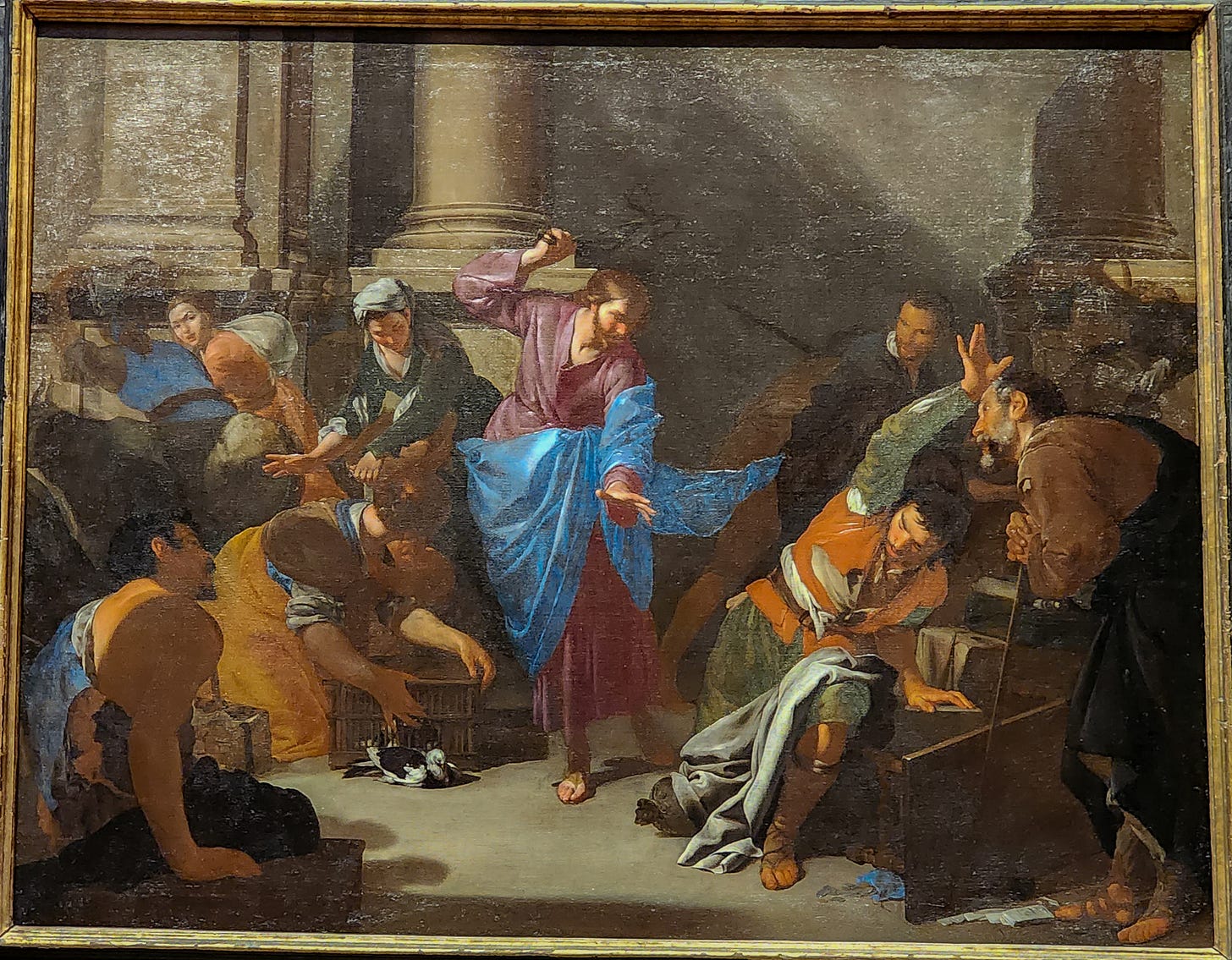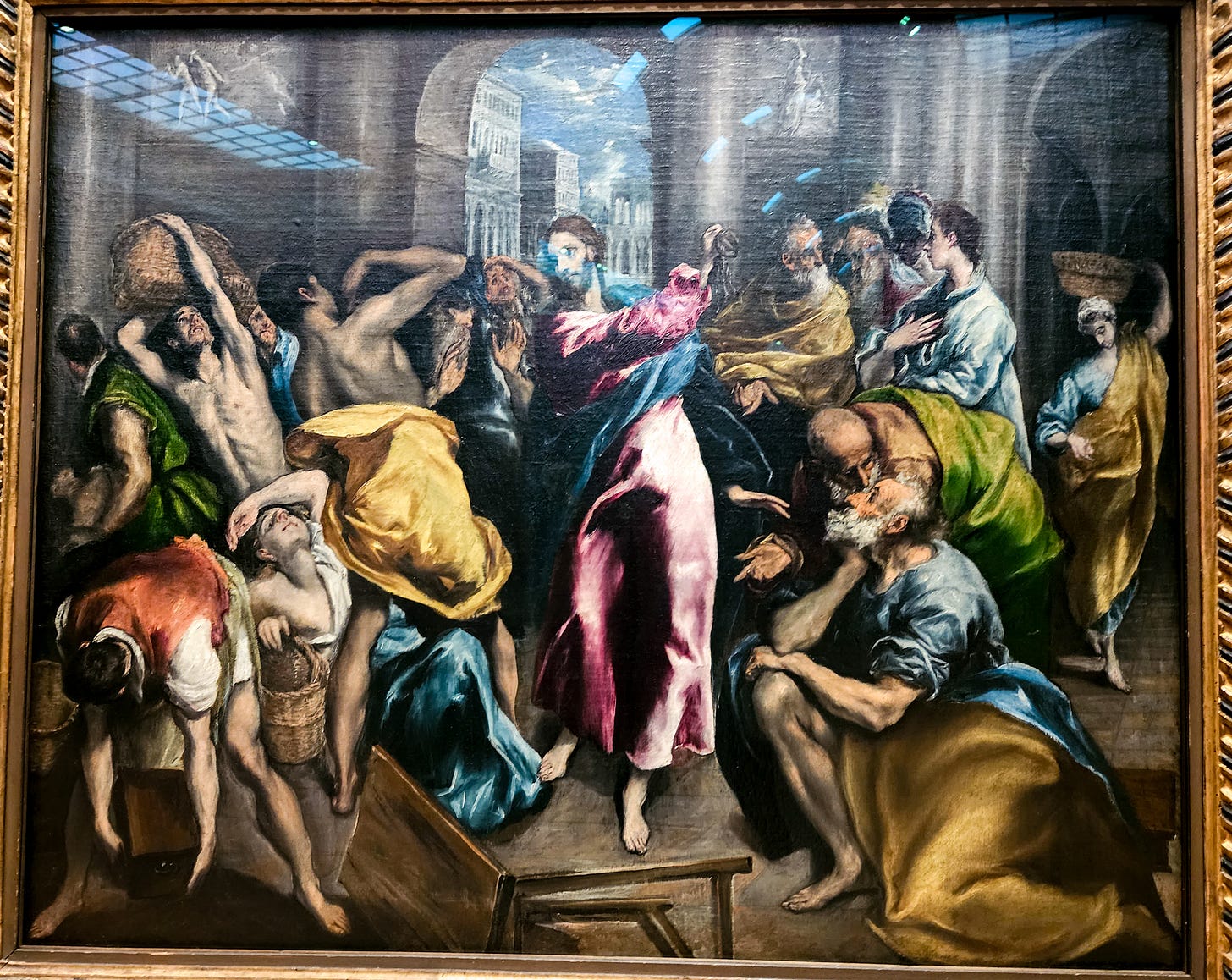“Then Jesus went into the temple of God and drove out all those who bought and sold in the temple, and overturned the tables of the money changers and the seats of those who sold doves.
And He said to them, ‘It is written, My house shall be called a house of prayer, but you have made it a den of thieves.’
Then the blind and the lame came to Him in the temple, and He healed them.”
Matthew 21: 12-14 (NKJV)
Holy Week Events Attributed to Day 2
Jesus cleanses the temple, driving out the money changers and sellers and those buying wares in the temple
He heals the blind and the lame who came to Him in the temple
He curses the fig tree
The chief priests, scribes, and leaders of the people seek how they might destroy Him.
Holy Week Day 2 Representations at National Gallery London
I was able to capture some representations of Day 2 at the Gallery of Jesus purifying the temple.
Christ Driving the Traders from the Temple. Bernardo Cavallino (c. 1645-1650). Oil on canvas
In this highly dynamic scene, Christ is at the center and is absolutely raging at the commercialization of His Father’s house, the Temple of Jerusalem. The tipped over tables and people trying to get out of his way, the chaos, the shock - “What are we doing wrong?” “We’re doing a service to the people!” “Are you kidding me? The Passover’s when we make our best money!” - Jesus was having none of it.
The only calm in the scene is the lone black and white dove, ironically a symbol of peace but here, a commodity.
But Jesus wasn’t peaceful here. He was dangerous. And Cavallino’s strategic use of light and shadow - similar to Caravaggio - and action and expression, enhances the fearsomeness of Christ. (Is fearsomeness a word? Did I just make it up?)
Bernardo Cavallino, a Neapolitan, may have painted this as a pair with Procession to Calvary which hangs at the Chrysler Museum of Art in Norfolk, Virginia. [Adding that to my list to see.]
Christ Driving the Traders from the Temple. Also know as The Purification of the Temple. El Greco (c.1570). Oil on canvas.
Unfortunately, I couldn’t avoid the glare from the room lights on the painting but hopefully you can still see the high emotion and drama that El Greco captured here. There’s such a crowd! The people in this painting really seem to be shocked, yes, but also there seems to me to be more agony at having to abruptly stop their trade. In this work, I can sort of feel the emotional desperation of the people at not having the profits or products from the anticipated trade in the temple.
Interestingly, El Greco painted five versions of this subject and this one in the National Gallery is one of the most familiar and prominent. There’s more architectural elements and there is a greater sense of perspective, space, and depth because of that, as compared to Cavallino’s version. The Venetian-like buildings in the background are a nod to Venice, the city where this particular Clearing of the Temple was painted and the influence of his counterparts in Venice, Titian and Tintoretto. El Greco would eventually became known for his exaggeratedly elongated figures but here in this earlier work there’s less of that.
I always associated El Greco with Spain (where he did later work prolifically), but I’m discovering today that he was born on the Greek island of Crete as Doménikos Theotokópoulos! Makes sense: “El Greco” = “The Greek”!
Expulsion of the Merchants from the Temple (Cacciata dei Mercanti dal Tempio). Ghiberti. (c. 1403-1424). North doors of the Florence Baptistery. Late Gothic to Early Renaissance.

I just got to wondering after revisiting the Baptistery doors in Florence with yesterday’s post, if the Purification of the Temple might also be represented there. (Twenty out of the twenty-eight total bronze panels of the North Doors, depict scenes from the life of Christ.) And, yes! There it is! I am dumbfounded at what Ghiberti accomplished, the detail and storytelling he was able to effect within the constraints of an approximately 20 ½ inches by 17 ¾ inches panel! I mean, the high drama of that scene is equally as pronounced or perhaps moreso than in the paintings in the National Gallery above.
The Baptistery doors are one of those places on earth where hours could be spent simply standing and gazing upon its supernatural mastery.
Today’s Bible Passages:
Matthew 21:10-19
Mark 11:12-18
Luke 19:45-48
Searching for the cursed fig tree in art (nothing at the National Gallery) would probably entail a PhD dissertation, I’m thinking. But, if I ever find anything about it, I’ll let you know!
In the meantime, on this Day 2 of Holy Week, may your sacred places and thin places and your heart remain without corrupting influence.
And may we always be aware that the God we serve is a dangerous God.







I'm so excited to see there is a Day 2 and now Day 3 that remains to be seen. Loving this adventure and especially the Easter topic. Thank you so much for sharing all of this. I learned something unexpected about El Greco!